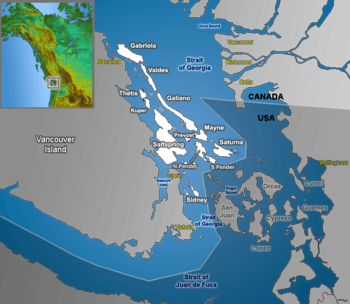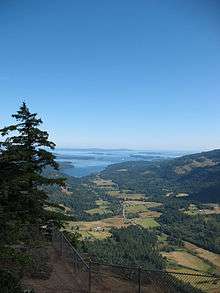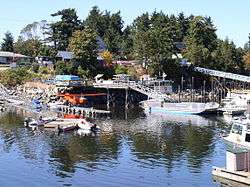Salt Spring Island
| Salt Spring Island | |
|---|---|
| Island | |
|
Salt Spring island | |
 The Southern Gulf Islands, including Salt Spring Island. | |
| Country | Canada |
| Province | British Columbia |
| Regional District | Capital |
| Government | |
| • MP | Elizabeth May (Green) |
| • MLA | Gary Holman (NDP) |
| Area | |
| • Land | 182.7 km2 (70.5 sq mi) |
| Population (2011 Census) | |
| • Total | 10,234 |
| • Density | 57.5/km2 (149/sq mi) |
| Time zone | PST (UTC−8) |
| • Summer (DST) | PDT (UTC−7) |
Salt Spring Island (also known as Saltspring Island) is one of the Gulf Islands in the Strait of Georgia between mainland British Columbia, Canada and Vancouver Island.[1]
The island was initially inhabited by various Salishan peoples before being settled by pioneers in 1859, at which time it was officially called Admiral Island. It was the first of the Gulf Islands to be settled and the first agricultural settlement on the islands in the Colony of Vancouver Island, as well as the first island in the region to permit settlers to acquire land through pre-emption. The island was retitled to its current name in 1910.[2]
Salt Spring Island is the largest, most populous, and the most frequently visited of the Southern Gulf Islands.

History
Salt Spring Island, or xʷənen̕əč, was initially inhabited by Salishan peoples of various tribes.[3][4] Other Saanich placenames on the island include: t̕θəsnaʔəŋ̕ (Beaver Point), čəw̕een (Cape Keppel), xʷən̕en̕əč (Fulford Harbour), and syaxʷt (Ganges Harbour).[4]
The island became a refuge from racism for African Americans who had resided in California.[3] They left California in 1858, after the state passed discriminatory legislation against blacks. Several of the families settled on this island; others on Vancouver Island. Before the emigration, Mifflin Wistar Gibbs and two other men had travelled up to the colony to interview Governor James Douglas about what kind of treatment they could expect there. He was a Guyanese man of multi-ethnic birth, and assured them that people of African descent in Canada were fairly treated as the colony had abolished slavery more than 20 years before.
The island was the first of the Gulf Islands to be settled by non-First Nations people. According to 1988's A Victorian Missionary and Canadian Indian Policy, it was the first agricultural settlement established anywhere in the Colony of Vancouver Island that was not owned by the Hudson's Bay Company or its subsidiary the Pugets Sound Agricultural Company.[5][6]
Salt Spring Island was the first in the Colony of Vancouver Island and British Columbia to allow settlers to acquire land through pre-emption: settlers could occupy and improve the land before purchase, being permitted to buy it at a cost per acre of one dollar after proving they had done so.[7] Before 1871 (when the merged Colony of British Columbia joined Canada), all property acquired on Salt Spring Island was purchased in this way; between 1871 and 1881, it was still by far the primary method of land acquisition, accounting for 96% of purchases.[7] As a result, the history of early settlers on Saltspring Island is unusually detailed.[8]
Demographically, early settlers of the island included not only African Americans, but also (largely) English and British Isles settlers, including Irish and Scottish, as well as aboriginal and Hawaiian.[9] The method of land purchase helped to ensure that the land was used for agricultural purposes and that the settlers were mostly families.[10] Ruth Wells Sandwell in Beyond the City Limit indicates that few of the island's early residents were commercial farmers, with most families maintaining subsistence plots and supplementing through other activities, including fishing, logging and working for the colony's government.[11] Some families later abandoned their land as a result of lack of civic services on the island or other factors, such as the livestock-killing cold of the winter of 1862.[12]
During the 1960s, the island became a political refuge for United States citizens, this time for draft evaders during the Vietnam War.[13]
The island's name
The island was known as "Chuan" or "Chouan" Island in 1854, but it was also called "Saltspring" as early as 1855, in honor of the island's salt springs.[14] In 1859, it was officially named "Admiralty Island" in honor of Rear-Admiral Robert Lambert Baynes by surveyor Captain Richards, who named various points of the island in honor of the Rear-Admiral and his flagship, HMS Ganges.[14] Even while named "Admiralty Island", it was referred to popularly as Saltspring, as in James Richardson's report for the Geological Survey of Canada in 1872.[5][15] According to records of the Geographic Board of Canada, the island was officially retitled Saltspring on March 1, 1910,[14] though the year 1905 is given by unofficial sources.[5] According to the Integrated Land Management Bureau of British Columbia, locals incline equally to Saltspring and Salt Spring for current use.[14] The official chamber of commerce website for the island, which gives a date of 1906 for the renaming, adopts the two word title, stating that the Geographic Board of Canada, in choosing the one word name, "cared nothing for local opinion or Island tradition."[16]
Geography and locale
Located between Mainland British Columbia and Vancouver Island, Salt Spring Island is the most frequently visited of the Gulf Islands as well as the most populous, with a 2011 census population of 10,234 inhabitants.[17] The largest village on the island is Ganges. The island is known for its artists.[13][18] In addition to Canadian dollars, island banks and most island businesses accept Salt Spring's own local currency, the Salt Spring dollar.[16][19]
The island is part of the Southern Gulf Islands, (Salt Spring Island, Galiano Island, Pender Island, Saturna Island, Mayne Island), which are all part of the Capital Regional District, along with the municipalities of Greater Victoria. Salt Spring Island's highest point of elevation is Bruce Peak.

Climate
| Climate data for Saltspring Island | |||||||||||||
|---|---|---|---|---|---|---|---|---|---|---|---|---|---|
| Month | Jan | Feb | Mar | Apr | May | Jun | Jul | Aug | Sep | Oct | Nov | Dec | Year |
| Record high °C (°F) | 14 (57) |
16 (61) |
19.5 (67.1) |
26 (79) |
32 (90) |
31.5 (88.7) |
31.5 (88.7) |
36.5 (97.7) |
32 (90) |
25.5 (77.9) |
16.5 (61.7) |
15 (59) |
36.5 (97.7) |
| Average high °C (°F) | 5.5 (41.9) |
7.3 (45.1) |
10.3 (50.5) |
13.5 (56.3) |
16.9 (62.4) |
19.5 (67.1) |
22.1 (71.8) |
22.3 (72.1) |
18.6 (65.5) |
13 (55) |
7.9 (46.2) |
5.3 (41.5) |
13.5 (56.3) |
| Average low °C (°F) | −0.4 (31.3) |
0 (32) |
1.3 (34.3) |
3.1 (37.6) |
5.9 (42.6) |
8.5 (47.3) |
10.3 (50.5) |
10.3 (50.5) |
7.6 (45.7) |
4.4 (39.9) |
1.5 (34.7) |
−0.2 (31.6) |
4.4 (39.9) |
| Record low °C (°F) | −14 (7) |
−13 (9) |
−10.5 (13.1) |
−3 (27) |
−1.5 (29.3) |
2.5 (36.5) |
3.5 (38.3) |
3 (37) |
−0.5 (31.1) |
−5 (23) |
−16 (3) |
−17.5 (0.5) |
−17.5 (0.5) |
| Average precipitation mm (inches) | 150.9 (5.941) |
125.1 (4.925) |
99.9 (3.933) |
67.3 (2.65) |
48.9 (1.925) |
37.5 (1.476) |
22.9 (0.902) |
27.6 (1.087) |
35 (1.38) |
88.5 (3.484) |
176.5 (6.949) |
148 (5.83) |
1,028.2 (40.48) |
| Source: Environment Canada[20] | |||||||||||||
Hiking trails
Salt Spring Island has several hiking trails. Two of hiking trails are rough and windy trails that lead to the summit regions of both Bruce Peak 709 meters (2,326 feet) above sea level, and Mount Tuam 602 meters (1,975 feet)above sea level. These 2 mountain peaks are the tallest points of land on the Southern Gulf Islands. Other short hikes can also be found on the island. One of these is the 2.5 km long trek to the summit of Mount Erskine which is 441 metre above sea level.
Notable residents

- Michael Ableman - author, organic farmer
- Nick Bantock - author and artist
- Robert Bateman - wildlife artist
- Arthur Black - CBC personality and humourist
- Brian Brett - poet and novelist
- Michael Colgan - nutritionist/bodybuilding writer
- Bill Henderson - singer-songwriter (The Collectors, Chilliwack)
- Dan Jason- author, organic farming advocate
- Sky Lee - artist and novelist
- Pearl Luke - award-winning author
- Harry Manx - musician and singer-songwriter
- Stuart Margolin - actor and director (The Rockford Files—former resident of Salt Spring Island)
- James Monger PhD, award-winning geologist
- Kathy Page - writer
- Briony Penn - professor (UVIC), author, and environmental activist.
- Jan Rabson - voice-over actor
- Raffi - singer-songwriter
- Clare Rustad - Canada women's national soccer team
- Malcolm Smith - motorcyclist
- Sylvia Stark
- Patrick Taylor - Northern Irish author
- Valdy - folk and country musician
- Phyllis Webb - poet and radio broadcaster
- Simon Whitfield - Olympic triathlon champion
- Ronald Wright - author
Education
- Sprott Shaw College, a private post-secondary institution, has a satellite campus on the island.
- Gulf Islands Secondary School
- Salt Spring Island Middle School
- Fulford Elementary School
- Salt Spring Elementary School
- Salt Spring Centre School
- Phoenix School
- Fernwood Elementary School
Transportation
Local bus transit on the island is provided by BC Transit.
BC Ferries operates between Tsawwassen and Long Harbour, as well as between Fulford Harbor-Swartz Bay and Vesuvis-Crofton.
Salt Spring Air, Seair Seaplanes and Harbour Air Seaplanes operate floatplane services from Ganges Water Aerodrome to Vancouver Harbour Water Airport and Vancouver International Water Airport. Kenmore Air operates between Ganges and Lake Union, Seattle, United States.
Communications
Telecommunications service providers include Telus and Shaw, with most wireless carriers providing coverage. The Island is served by the Ganges and Fulford Harbour exchanges.
See also
- Salt Spring Air
- Seair Seaplanes
- Long Harbour, British Columbia
- Ruckle Provincial Park
- Wallace Island Marine Provincial Park
References
- ↑ "Natural Resources Canada-Canadian Geographical Names (Saltspring Island)". Retrieved 2014-09-07.
- ↑ "The Province of British Columbia GeoBC (Saltspring Island)". Retrieved 2014-09-07.
- 1 2 Schulte-Peevers, Andrea (2005). Canada (9 ed.). Lonely Planet. p. 729. ISBN 1-74059-773-7.
Originally settled by the Salish First Nation over a thousand years ago, it became a place where African Americans fled to escape racial tensions in the USA
- 1 2 "Saanich Place Names". Saanich Classified Word List. Retrieved 2012-07-16.
- 1 2 3 Hill and Hill, 241.
- ↑ Nock, David A.; Canadian Corporation for Studies in Religion (1988). A Victorian Missionary and Canadian Indian Policy: Cultural Synthesis vs. Cultural Replacement. Wilfrid Laurier Univ. Press. pp. 159–160. ISBN 0-88920-153-6.
- 1 2 Sandwell, Ruth Wells (1999). Beyond the City Limits: Rural History in British Columbia. UBC Press. p. 85. ISBN 0-7748-0694-X.
- ↑ Sandwell, Ruth Wells (2005). Contesting Rural Space: Land Policy and Practices of Resettlement on Saltspring Island, 1859-1891. McGill-Queen's Press -MQUP. p. 3. ISBN 0-7735-2859-8.
- ↑ Sandwell, Contesting, 4.
- ↑ Sandwell, 89-90.
- ↑ Sandwell, Beyond, 90-91.
- ↑ Sandwell, Beyond, 93.
- 1 2 Hill, Kathleen Thompson; Gerald N. Hill (2005). Victoria and Vancouver Island: A Personal Tour of an Almost Perfect Eden (5 ed.). Globe Pequot. p. 242. ISBN 0-7627-3875-8.
- 1 2 3 4 "Origin Notes and History". Integrated Land Management Bureau of British Columbia. Archived from the original on May 29, 2008. Retrieved 2009-03-03.
- ↑ Richardson, James (1872-05-01). "Report on the coal fields of the East Coast of Vancouver Island". Report of Progress - Geological Survey of Canada. Geological Survey of Canada.
Southward of Saltspring Island, or, as it is named upon the chart, Admiralty Island, are situated
- 1 2 "Visitors: About Salt Spring Island". Salt Spring Island Chamber of Commerce. Retrieved 2009-03-09.
- ↑ Statcan: 2011 Census
- ↑ Thompson, Wayne C.; Jacqueline Grekin (2003). Canada. (5 ed.). Hunter Publishing, Inc. p. 633. ISBN 2-89464-476-0.
- ↑ Official Salt Spring Currency Website
- ↑ Environment Canada—Canadian Climate Normals 1971–2000, accessed 28 March 2010
External links
| Wikimedia Commons has media related to Saltspring Island. |
| Wikivoyage has a travel guide for Saltspring Island. |
- "Saltspring Island". BC Geographical Names.
- Salt Spring Island Chamber of Commerce
- Saltspring Island photography by John Cameron
- photography and video about Salt Spring Island by Kmax
- Islands Trust, Salt Spring Island
Coordinates: 48°50′N 123°30′W / 48.833°N 123.500°W
